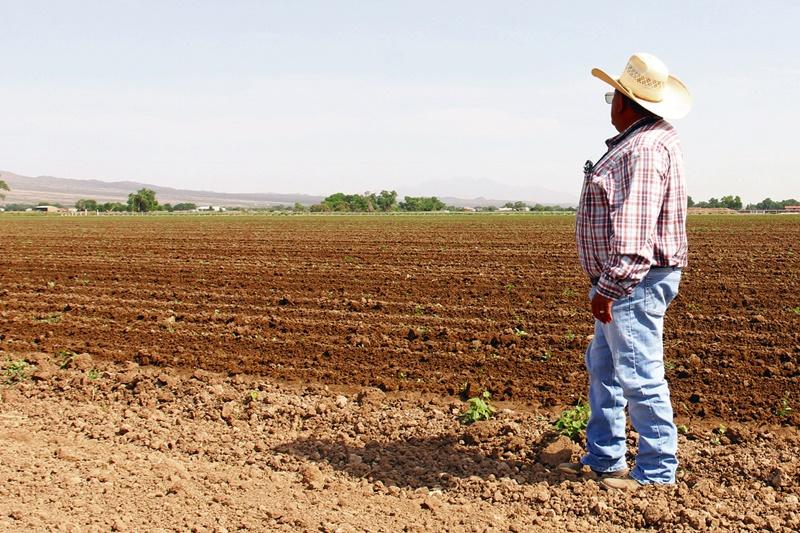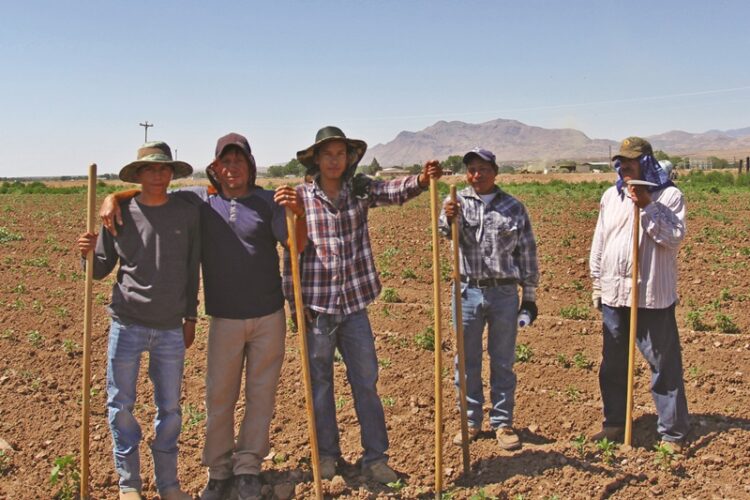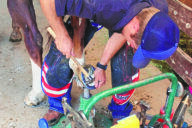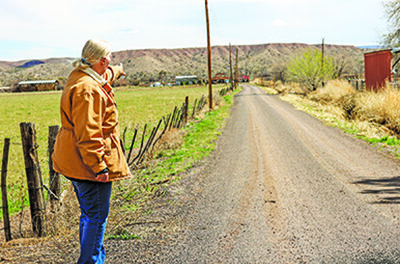
Farmer Glen Duggins shows one of his private wells; private wells will help Cinco Estrella Farm get through the season.
Juan Baeza | El Defensor Chieftain Intern photos
The irrigation season has been cut short due to drought once again. Despite the challenges, local farmers remain hopeful.
With an irrigation season that usually runs till October, the Middle Rio Grande Conservancy District told farmers that the season could be over before June ends. This could be devastating for Socorro’s local farmers as many of them do not have private wells on their land to maintain throughout the season.
Socorro County is dealing with a D4 level (Exceptional Drought) of drought in 90 percent of the county. This means that no surface water is left for agriculture, asking farmers to rely on private wells. The mid-section of the Rio Grande is going dry. This past May was the driest on record in the past 128 years for New Mexico.

Mario Rosales checks on a newly irrigated chile field at Rosales Farm. Irrigation season appears to
be ending early for the third
year in a row.
Local farmer and owner of Rosales Produce, Mario Rosales, says that drought is all part of the game, and they plan to get by this season just like they have done in the past.
“If they do shut it off, we will still get a trickle of the water. We will be on a tight squeeze, but we just got to go with the flow. Because there’s nothing we can really do,” Rosales says.
Rosales said there’s no point in getting mad or trying to find someone to blame. As a former ditch rider, Rosales understands both sides—the farmers and the ditch riders. Ditch riders are MRGCD employees who manage the irrigation ditches. Rosales understands that people can get anxious, but he says that there’s nothing the MRGCD or ditch riders can do.
“If there’s no water, then there’s no water. We got to leave the rest to the man upstairs and rock with what we have.”
Rosales has two fields with private wells, so he can rely on those to pass the season, but he has one field that relies completely on the ditch and river water for irrigation. Despite this Rosales is hopeful things will still turn out. “We might not have 60 or 70 acres of chile but if we can at least get 50 or 40. Whatever we get, we are going to be good.”
Despite the drought, Rosales is confident they will get through because this is something they have faced before.
“Somehow, someway, we have always made it through. The water always ends up coming from somewhere. We just keep our faith and continue with the job.”
Corky Herkenoff is another local farmer that is being heavily affected by the drought. Residing in San Acacia, the owner of Indian Hill Farms had to resort to installing and drilling for a private well. This comes at a hefty price. “It costs around $80 thousand dollars to install a well and now it’s taking us even longer because we are still waiting on pieces to be delivered,” Herkenoff said.
Indian Hill Farms relies heavily on the river and ditch irrigation to get water to its hay fields. There is one private well, but that would only supply around 10 percent of the farm with water.
“We are hoping the rain can come and save us, but the quality of the water is important,” said Herkenoff. “I know they will try and collect the rainwater from various places like El Rio Puerco, but they call it that for a reason. The water tends not to be very clean.”
This becomes a problem because the quality of the hay begins to deteriorate.
On top of the drought, Herkenoff points at inflation as another huge blow to this season.
“Every season we use a total of five fertilizers for the farm. This is the first season that I won’t be able to do that because we just can’t afford to do so. We will run only one fertilizer this year and that load cost $28 thousand.”

Pura raza buena y Trabajadora en Cinco Estrella Farm. (The good working class at Cinco Estrella Farms.)
Glen Duggins is another local farmer facing the drought. The owner of Cinco Estrella Chile said he’s one of the fortunate farmers who was able to prepare for this problem.
“We prepared by putting pipelines, cement on ditches, and drilled wells for back up.”
This comes at a price. Although he’ll be able to get his chile out, Duggins said it will cost him around $500 a day to run the wells.
Duggins points out that unfortunately many farmers within the middle of the Rio Grande do not have personal wells to rely on, including many of his neighbors.
“Those farms are going to have it very rough; they will see quite a loss.”
Duggins, like Rosales, thinks water will come down the irrigation canals eventually—when it rains, but it still may not be enough to make it through the season.
“We still have to wait on the rainwater. They will put it on the canals, but we’ll see how quickly that goes,” Duggins says.
Having a private well allows Duggins to maintain a steady irrigation. He usually irrigates every two weeks, but timing depends on the crop and when it demands water.
“We’ll do our best to keep the same pace of irrigation and I’m hoping we aren’t going to be as affected but we will be affected with the prices. Everything is already expensive so adding this to it will only drive the price up,” Duggins said.
Duggins pointed at a pallet of fertilizer he had just purchased.
“I had to pay $8,000 for that pallet and it’s only one pallet.”
Despite rising prices, Duggins says that farmers have kept their cool and that uncertainty is something that comes with the job.
“We know it’s coming, and we get seasoned to it. Sometimes you might lose your crops and there’s no point in throwing a tantrum. We’ll just have to do better next time.”
Duggins asks the community to continue with their support and to buy local.
“As a farmer that works at this craft religiously every day, we get used to the heartbreak. Of course, the good outweighs the bad, but it’s not for everybody. It’s a constant roll of the dice.”





















